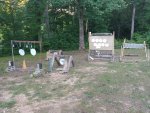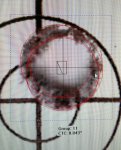when i was super active in testing ammos, my procedure was:
waiting on a day were conditions where favorable....low to mid humidity, baro pressure, around 70 deg f. cloudy if possible, <5mph wind, setting rifle on a bench, front and rear rest, chronograph 10 ft in front of muzzle. if i felt that i "pulled" a shot i'd note where it printed and shoot another in a 15 round group.
if i couldn't get the ammos tested in the same session either due to time or a big shift in environmental factors, i'd stop there and not do a thing until another day where the environmentals were comparable to the previous session.
i'd so the same procedure below at different distances (usually 50 & 100 as a baseline). if they were "specialty" subsonics i'd do 25, 50, 100Y.
i'd weight sort and rim thickness sort each of the ammos to give the best "randomness" that i can get. i'd notate that and also the type (if any) factory lube or wax. i'd also notate the amount of bullet drop between testing distances
after firing i'd also notate the amount of fouling remaining in the barrel before dry swabbing it and the muzzle crown before an ammo switch.
i'd give each ammo a "rating" either with a clean barrel, dirty barrel, etc. the rating would also be further broken down into the distances shot, and then cumulatively over all the distances. also included those pesky "fliers".
by no means is it based on anything other than after crunching the data into spreadsheets and trend analysis, it spit out for the the ammos tested (at least for me) the best ammo to use at a specific or multiple distance or particular discipline competing in, and adding a cost per round factor that allowed me to decide that if i wanted to pay top dollar for the best performer or is short on cash how much consistancy i was willing to give up for available funds vs the amount of and type of shooting to be done.
at the end of it the data proofed out what groups were printed on target and visca versa.
one thing i've realized since i did oodles of tests i ran circa 2009 - 2012 is that i had a whole lotta time on my hands!
copied and pasted from an old post (please excuse the all caps):
THESE ARE THE TERMS, RATING #’S, AND EQUATIONS USED WITH MEASUREMENTS AND TESTING PARAMETERS TO GIVE AN OBJECTIVE JUDGEMENT ON THE AMMO USED.
MG = MEASUREMENT OF “MAJOR GROUP” (EXCLUDING FLYERS) EG = MEASUREMENT OF “EXTENDED GROUP” (INCLUDING FLYERS)
(THINKING OF MG AND EG AS THE INSIDE AND OUTSIDE SPREAD ON A DEER RACK)
FL = FLYERS (SHOTS NOTICABLY DEVIATED FROM MG) FR = FLYER RATIO (# OF FLYERS / OUT OF 15 ROUNDS)
CBR = CLEAN BARREL RATING - (BARREL WAS DRY SWABBED, SHOT 5 RDS (30 SECONDS BETWEEN, DRY SWABBED AGAIN BETWEEN CHANGING AMMO). THIS RATING WAS DERIVED BY ADDING MEASUREMENTS OF MAJOR GROUP, EXTENDED GROUP, AND NUMBER OF FLYERS, DIVIDED BY 3 (# OF CATAGORIES). GAVE AMMO THAT SHOT WELL IN A CLEAN BARREL A RATING.
MG + EG + FLYERS DIVIDED BY 3 = CBR
DBR = DIRTY BARREL RATING - BARREL WAS DRY SWABBED, SHOT 10 RDS (30 SECONDS BETWEEN, DRY SWABBED AGAIN BETWEEN CHANGING AMMO). THIS RATING WAS DERIVED BY ADDING MEASUREMENTS OF MAJOR GROUP, EXTENDED GROUP, AND NUMBER OF FLYERS, DIVIDED BY 3 (# OF CATAGORIES), AND GAVE AMMO THAT SHOT WELL IN A DIRTY BARREL A RATING.
MG + EG + FLYERS DIVIDED BY 3 = DBR
CR = CONSISTANTCY RATING - INCLUDED THE ALL OF THE FACTORS OF CBR AND DBR, DIVIDED BY 6 (# OF CATAGORIES). IT WAS DESIGNED TO GIVE A CONSISTANTCY VALUE, AS SOMETIMES TIGHT GROUPS ARE SPOILED BY A DISTANT FLYER OR TWO AND MORE OPEN GROUPS WERE HELPED BY CLOSER FLYERS. SINCE THIS RATING USES ALL THE FACTORS IN A CLEAN AND DIRTY BARREL, AND ANY FLYERS ASSOCIATED, I THOUGHT IT WOULD GIVE AN ALL AROUND GRADE OF PERFORMANCE / CONSISTANTCY. THINK OF IT AS THE MOST SHOTS YOU CAN GET INTO AND / OR “NICK” A QUARTER AT 50 YDS, CONSISTANTLY. IT GAVE AMMO A RATING SHOT THROUGH A CLEAN AND DIRTY BARREL, AND GAVE RATING OF THE AMMO USED THROUGH BOTH. USED ALL 15 ROUNDS.
MG + EG + FLYERS OF CBR AND DBR = CR
VR = VALUE RATING - THIS ADDED A PRICE PER ROUND (PPR) FACTOR, WHICH AT FIRST I DIDN’T THINK WAS IMPORTANT, HOWEVER AS WE KNOW SOME MATCH / TARGET AMMO CAN BE PRICEY. THIS “PERFORMANCE PER COST” ACTUALLY HELPED ME OUT ON PICKING A PRACTICE AMMO THAT GIVES SIMILAR PERFORMANCE TO MY TOP SHELF AMMO. THIS ALSO HELPED ME RATE LOWER PRICED AMMO COMPARED TO FLYERS, ETC. WHICH HELPED IT OUT IN THE OVERALL RATINGS. CLEAN AND DIRTY BARREL MEASUREMENTS, PLUS PRICE PER ROUND, DIVIDED BY 7 (THE AMOUNT OF FACTORS USED).
MG + EG + FLYERS (OF CBR) + MG + EG + FLYERS (OF DBR) + PPR DIVIDED BY 7 = VR
OAR = OVERALL RATING - BASICALLY TOOK ALL THE RATINGS AND CAME UP WITH AN “OVERALL RATING” WHICH I WOULD BELIEVE JUDGES AN AMMO USING ALL FACTORS DESCRIBED ABOVE, AND GIVES THE BEST USAGE OVER MANY FACTORS.
CBR + DBR + CR + VR DIVIDED BY 4 = OAR
IN ORDER TO KEEP THINGS SOMEWHAT SIMPLIER, IF A GROUP WAS JUST UNDER 1”, 1/2” (.5’), ETC., IT IS MARKED -1”, -1/2” (-.5”), JUST OVER +1”, +1/2” (.5”), ETC. IT WAS THEN ROUNDED TO THE NEXT WHOLE NUMBER IN RATINGS.
then came the "multi yard rating" MULTI YARD RATING (MYR), which was an average of 50 & 100Y data to come up with an overall performance metric across multiple ranges, clean / dirty barrels, and "fliers"
CBR OF 50 + 100 DIVIDED BY 2 = CBR / MYR
DBR OF 50 + 100 DIVIDED BY 2 = DBR / MYR
CR OF 50 + 100 DIVIDED BY 2 = CR / MYR
VR OF 50 + 100 DIVIDED BY 2 = VR / MYR
CBR + DBR + CR + VR OF 50 AND 100 = MYR OAR
---------------------------------------------------------------------
.....and then came the rimthickness tests, weight sort tests, bullet sizers and DIY bullet lube tests.
i can't picture doing the same break down today with as much specialty target & "long range" ammo that is out there today and bumping it up against the stuff available 10 years ago. but then again it just might shake out that the "new generation of .22lr" may or may not be all that it's cracked up to be vs the time tested wolf, sk, CCI std vel, etc.
wish i still had the time and "gumption" to do it.








